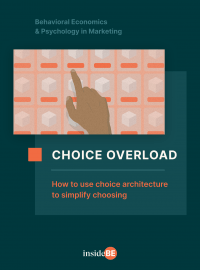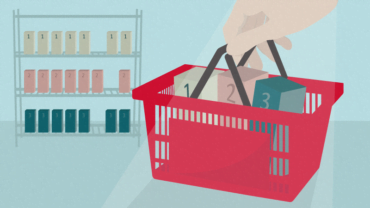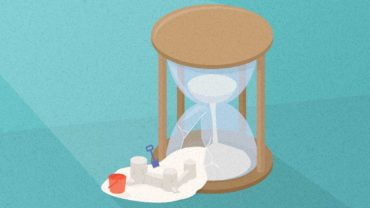The 5 Most Important Behavioral Principles in Marketing According to Experts

Behavioral principles are a must if you want to gain a competitive edge in your industry. But is there one that stands out above the rest? What principle is the most important marketing tool? We asked four behavioral experts and here’s what they came up with.
In this article, you’ll discover:
- 5 behavioral principles that can turn your marketing around;
- The fundamentals of BE that experts advise not to overlook at all costs; and
- The do’s and don’ts for basically any marketing campaign.
Over the years, psychology and behavioral economics have found hundreds of intuitive shortcuts that people use to make their daily decisions, even purchase-related ones. These are often referred to as “behavioral principles”, as they drive human behavior.
But what’s the most important behavioral principle when it comes to marketing and sales? What’s the one that’ll make your customers really inclined to buy? Well, we asked 4 of the world’s leading BE experts what they think. So, without further ado, here are the Top 5 Behavioral Principles You Shouldn’t Underestimate.

Discover ground-breaking ideas and fascinating solutions.
Make it attractive and easy
Just to make things clear before we dive in, there’s no magic bullet and there’s no one principle that’ll turn your world around. In most cases, you’ll need an elaborate behavioral strategy. This fact is pointed out quite nicely by behavioral scientist and consultant Patrick Fagan, who simply couldn’t pick just one go-to nudge.
If customers can’t see a reason why they should buy something, why an offering is relevant to them, or what pain it will spare them, then they simply won’t have any reason to buy.
If customers can’t see a reason why they should buy something, why an offering is relevant to them, or what pain it will spare them, then they simply won’t have any reason to buy. Remember, customers are irrational, but there are limits even to this irrationality.
“The most important principle in online sales is the Fogg Behavior Model, which is actually more like two principles: make it attractive and make it easy. Firstly, always think, “What’s in it for me?” from the customer’s point of view – why should they care?”
Patricks continues: “What are the emotional motivations that would make them buy? Emotion is the steam in the engine that drives behavior, there has to be some initial spark to motivate the sale.”
Friction
The second principle Patrick mentioned is making the desired behavior as easy as possible: “Then, once the engine is running, you need to clear the road of all barriers and make the sale as easy as possible. Reduce friction like the need to sign in, buttons being hard to find, etc., and just make it quick and simple.”
Friction works both ways: removing it makes the behavior easy, like for example reducing the food waste, but you can also add friction to slow your customers just at the right moment to make them buy.
Remove uncertainty
Let’s stick with the barriers for a little bit. Some of them are clearly visible, like physical obstacles, a terrible user interface, or simply too many steps to complete along the customer’s purchase journey.
Then, there are hidden barriers. One of them is uncertainty: an invisible sales killer. It’s also the most important behavioral principle according to Matej Sucha, CEO of Mindworx Behavioral Consulting.
Uncertainty
Uncertainty is a situation when your customer has incomplete or missing information. A situation when their questions, concerns, and fears aren’t answered.
“Regardless of how amazing your product objectively is or how great of a deal it might be, if your customers feel uncertain about any small thing during the purchase process, they’ll postpone their decision to buy, or worse: not buy at all.”
This has proven to be true throughout Matej’s career time and time again. But by considering the customers’ uncertainties, Mindworx managed to increase an insurance company’s direct e-mail conversions by 300% and also triple the number of reactions to job ads for another company.
“Removing uncertainties is one of the first things we try to do in our projects. Not only because behavioral economics tells us so, but also because it’s been repeatedly shown that it works wonders and is something successful companies can build their success on.”
Don’t overwhelm customers with too many options
It’s no surprise that this behavioral principle made it to this list: choice overload. It’s the favorite pick of Lea Karam, a behavioral scientist, and strategy consultant at the behavioral consultancy behave.
“Simply put, this means the more choices you present to someone, the more overwhelmed that person becomes and the less satisfied they’ll be with their purchase,” she says.
Choice Overload
Choice overload is a result of too many choices being available. It can result in decision fatigue, sticking to the default option, or even avoiding making a decision altogether.
It’s the 2020s and these days, we’re always in a constant hurry, overwhelmed with our responsibilities and mobile notifications. And as Lea aptly puts it, “We live in an extremely connected world with people’s bargaining power and consideration set greater than ever before. And to top it all off, their attention span is increasingly on the decline.”
So what happens when customers are faced with too many options to choose from?
“It can lead to even further indecisiveness than during the pre-digitalization era and very often, a risk of opting out from the purchase altogether. I’ve seen brands overlooking this both in their comms and product activities in the hopes of communicating their broad offering vs. competition.
“Nevertheless, a smart brand today will embody this principle and work towards building out choice attributes in a way that simplifies people’s lives and reduces their cognitive efforts,” Lea adds.
And guess what, smart brands really do it. Netflix, for example, works with the choices it provides to customers perfectly. And there’s no doubt this is a part of their success.
Nevertheless, she also explains that multiple principles are needed for achieving optimal success with a marketing campaign. So don’t forget, the best use of behavioral economics is an elaborate behavioral strategy.
Consider the context
Last but definitely not least, whatever campaign you are going to launch, always consider the context. Products and their prices don’t exist in a vacuum.
To make sense of whether the product is a good deal or not, customers need to compare it with something else: either with another product they already know or simply with other products surrounding it.
“It’s not so much a single established principle, but the ethos that context is king should be foregrounded a lot more within the field of behavioral science,” says Benny Cheung, a behavioral scientist from Dectech.
It’s not so much a single established principle, but the ethos that context is king should be foregrounded a lot more within the field of behavioral science
Context is a marketing superweapon you definitely shouldn’t overlook. Benny summed it up quite nicely when he said, “Human beings’ perception and decision-making is malleable, so if the context changes, everything changes.”
That’s why, for example, Rolls-Royce and Maserati don’t sell their cars at car shows. What they do instead is sell them at yacht and plane shows, where among their bigger and pricier brothers, cars suddenly don’t look that pricey.
“It’s also the reason why at Dectech, we advocate in-situ A/B testing or quasi-experimentation that replicate reality closely if the former is not possible, before launching any new proposition in the field. Rigorous testing capability is now readily available. There’s no need or excuse for relying on gut feelings alone” adds Benny.
While working on a campaign, always take the context into account. Consider the situation, surroundings your customers will see the product in, and the options they will compare it to. Consider the time of year, week, or day when the customer will see your offer.
Context shapes our decisions. And once you understand that, you can change it to your advantage. Like Nespresso, which managed to sell their customers coffee with a price equivalent to €45 for a regular bag.
Key Takeaways:
- For customers to buy, they need to feel the need to do it. Be very vocal about what value your product will bring them and what pain it will spare them.
- Once customers feel a need, make the purchase process as easy as possible.
- One of the biggest barriers customers face is uncertainty. If they feel unsure about anything during the purchase process, they simply won’t buy. Make sure to get rid of any uncertainty they could possibly have.
- Don’t overwhelm your customers with too many options. Decision-making requires time and energy, and customers’ attention span is not that great. Once they feel overwhelmed, they won’t buy.
- Always consider the context that your customers make decisions in. Think about the surroundings they’ll see the product in and the options they’ll compare it to.






Everything along the customer’s journey, which is objectively a little harder than it should be. it needs to be removed to elicit a desired behavior or response.